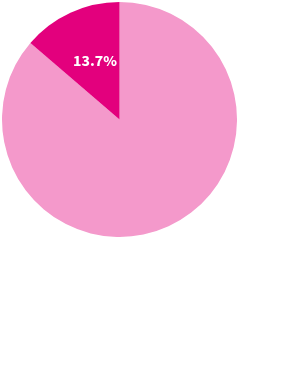How many students are enrolled in charter schools?
The share of public school students enrolled in charter schools varies by state, ranging from 0% to 45.3%.
In the fall of 2022, 3.7 million students — 7.6% of public school students nationally — attended charter schools. That’s up from 4.6% a decade prior.
At that same time the percentage of non-charter public school students dropped, from 95.4% to 92.4%.
In some parts of the US, more than 20% of K-12 students now attend charter schools.
What is a charter school?
A charter school is a public school of choice: parents can choose to send their children there instead of to their assigned neighborhood school. Charter schools get public funding and have many of the same legal requirements as traditional public schools — state testing, nondiscrimination policies, health and safety standards. And like all public schools, charter schools can’t charge tuition or have a religious affiliation.
They operate under a contract called a “charter” that outlines the school’s purpose, mission, governance, enrollment plans, and target student outcomes. These outcomes may range from specific goals like preparing students for postsecondary education to broader aims like developing leadership skills.
Each charter school is overseen by an “authorizer,” a local or state entity that monitors the school’s academic performance and financial practices. Charter schools can be started by individuals or groups who identify a need that isn’t being met by existing public schools. When more students apply than there are available seats, a lottery is often used to determine enrollment.
Although charter schools have more freedom than traditional public schools in areas like curriculum, staffing, and school management, schools are still required to meet state and national education standards.
Which states have the most students enrolled in charter schools?
In 2022, biggest populations of charter school students were in California (645,732), Texas (468,935), and Florida (382,367). They were also the three states with the highest populations.
As a percentage of total students, California’s charter schools enrolled 11.9% of its public school students. Texas charter schools taught 8.5% of students, and Florida’s taught 13.3%.
Arizona and Washington, DC, had the highest percentage of students in charter schools, at 20.5% and 45.3%. They were the only two locales in the nation with more than a fifth of public school students going to charter schools.
In eight states – Colorado, Nevada, Florida, Louisiana, Delaware, California, Utah, and Michigan – between 10.0% and 19.9% of public-school students were enrolled in charter schools.
Six states had no students at all in charter schools: Montana, Nebraska, North Dakota, South Dakota, and Vermont don’t have laws allowing charter schools, and Kentucky introduced charter school legislation in 2022 but didn’t have any open charter schools during the 2022–23 school year.
In the remaining 35 states, between 0.1%-9.9% of public school students were in charter schools. Charter school enrollment was less than 1% in Alabama, Mississippi, Wyoming, Kansas, West Virginia, Washington, Virginia, and Iowa.

How has charter school enrollment changed over time?
Between 2012 and 2022, charter enrollment increased in 42 states and in Washington, DC. The biggest percentage point rise was in Nevada, where enrollment went up 9.21 percentage points (4.99% to 14.20%). The states with the next-highest percentage point increases were Louisiana (6.75 percentage points) and Arizona (6.64).
Three states established charter schools for the first time in that decade, so enrollment there increased from zero to 0.74% of public school students (Mississippi), 0.50% (West Virginia), and 0.43% (Washington).
Enrollment declined, though not drastically so, in two states: Kansas, by –0.09 percentage points (from 0.61% of students to 0.52% and Iowa, by –0.02 (0.07% to 0.05%).
There was no change in Kentucky, Montana, Nebraska, North Dakota, South Dakota, and Vermont, since none had any open charter schools.
Learn more about what matters most to parents when choosing a school and get the data straight to your inbox by signing up for our weekly newsletter.
